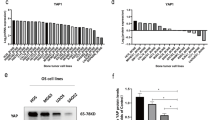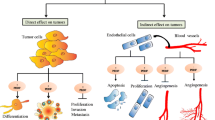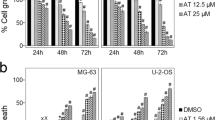Abstract
Osteosarcoma is major cause of cancer-related death in the pediatric age group, and this is due to the development of pulmonary metastases that fail to be eradicated with current treatment regimes. Although there have been significant improvements in the long-term survival of such patients, 25–50% with initially non-metastatic disease, subsequently develop metastases and this remains the major cause of death for these patients. In this study, we report the multimodal activity of pigment epithelium-derived factor (PEDF) in inhibiting osteosarcoma growth, angiogenesis and metastasis. In vitro, we found that administration of recombinant PEDF (rPEDF) on two osteosarcoma cell lines (rat UMR 106-01 and human SaOS-2) significantly reduced tumor cell proliferation and increased apoptosis, as well as decreased cell invasion, angiogenesis, and increased adhesion to collagen type-1. Administration of rPEDF upregulated the mRNA expression of phenotypic osteoblast differentiation markers (ALP, pro-α1 collagen and osteocalcin) in a pre-osteoblastic cell line, UMR 201, and also increased mineralized nodule formation in both UMR 106-01 and SaOS-2. In vivo, rPEDF dramatically suppressed primary osteosarcoma growth and the development of macroscopic pulmonary metastases in an orthotopic model of human osteosarcoma (SaOS-2). Interestingly, no activity was seen in tumors grown subcutaneously, suggesting a paracrine interaction between PEDF and the bone microenvironment. Preliminary pharmacoevaluation studies demonstrated rPEDF stability within media containing serum and osteosarcoma cells, and no gross systemic toxicity was observed in vivo with rPEDF administration. These results suggest that PEDF is emerging as an attractive and clinically appealing drug candidate for the treatment of osteosarcoma






Similar content being viewed by others
Explore related subjects
Discover the latest articles and news from researchers in related subjects, suggested using machine learning.References
Hanahan D, Weinberg RA (2000) The hallmarks of cancer. Cell 100:57–70
Ferrari S, Smeland S, Mercuri M et al (2005) Neoadjuvant chemotherapy with high-dose Ifosfamide, high-dose methotrexate, cisplatin, and doxorubicin for patients with localized osteosarcoma of the extremity: a joint study by the Italian and Scandinavian Sarcoma groups. J Clin Oncol 23:8845–8852
Petrilli AS, de Camargo B, Filho VO et al (2006) Results of the Brazilian Osteosarcoma treatment group studies III and IV: prognostic factors and impact on survival. J Clin Oncol 24:1161–1168
Ek ET, Choong PF (2006) The role of high-dose therapy and autologous stem cell transplantation for pediatric bone and soft tissue sarcomas. Expert Rev Anticancer Ther 6:225–237
Quan GM, Ojaimi J, Nadesapillai AP et al (2002) Resistance of epiphyseal cartilage to invasion by osteosarcoma is likely to be due to expression of antiangiogenic factors. Pathobiology 70:361–367
Dawson DW, Volpert OV, Gillis P et al (1999) Pigment epithelium-derived factor: a potent inhibitor of angiogenesis. Science 285:245–248
Volpert OV, Zaichuk T, Zhou W et al (2002) Inducer-stimulated Fas targets activated endothelium for destruction by anti-angiogenic thrombospondin-1 and pigment epithelium-derived factor. Nat Med 8:349–357
Cai J, Jiang WG, Grant MB et al (2006) Pigment epithelium-derived factor inhibits angiogenesis via regulated intracellular proteolysis of vascular endothelial growth factor receptor 1. J Biol Chem 281:3604–3613
Pignolo RJ, Francis MK, Rotenberg MO et al (2003) Putative role for EPC-1/PEDF in the G0 growth arrest of human diploid fibroblasts. J Cell Physiol 195:12–20
Abe R, Shimizu T, Yamagishi S et al (2004) Overexpression of pigment epithelium-derived factor decreases angiogenesis and inhibits the growth of human malignant melanoma cells in vivo. Am J Pathol 164:1225–1232
Crawford SE, Stellmach V, Ranalli M et al (2001) Pigment epithelium-derived factor (PEDF) in neuroblastoma: a multifunctional mediator of Schwann cell antitumor activity. J Cell Sci 114:4421–4428
Filleur S, Volz K, Nelius T et al (2005) Two functional epitopes of pigment epithelial-derived factor block angiogenesis and induce differentiation in prostate cancer. Cancer Res 65:5144–5152
Ek ET, Dass CR, Choong PF (2006) Pigment epithelium-derived factor: a multimodal tumor inhibitor. Mol Cancer Ther 5:1641–1646
Hase R, Miyamoto M, Uehara H et al (2005) Pigment epithelium-derived factor gene therapy inhibits human pancreatic cancer in mice. Clin Cancer Res 11:8737–8744
Doll JA, Stellmach VM, Bouck NP et al (2003) Pigment epithelium-derived factor regulates the vasculature and mass of the prostate and pancreas. Nat Med 9:774–780
Cheung LW, Au SC, Cheung AN et al (2006) Pigment epithelium-derived factor is estrogen sensitive and inhibits the growth of human ovarian cancer and ovarian surface epithelial cells. Endocrinology 147:4179–4191
Fisher JL, Mackie PS, Howard ML et al (2001) The expression of the urokinase plasminogen activator system in metastatic murine osteosarcoma: an in vivo mouse model. Clin Cancer Res 7:1654–1660
Dass CR, Ek ET, Contreras KG et al (2006) A novel orthotopic murine model provides insights into cellular and molecular characteristics contributing to human osteosarcoma. Clin Exp Metastasis 23:367–380
Nadiminty N, Lou W, Lee SO et al (2006) Prostate-specific antigen modulates genes involved in bone remodeling and induces osteoblast differentiation of human osteosarcoma cell line SaOS-2. Clin Cancer Res 12:1420–1430
Fahmy RG, Dass CR, Sun LQ et al (2003) Transcription factor Egr-1 supports FGF-dependent angiogenesis during neovascularization and tumor growth. Nat Med 9:1026–1032
Ek ET, Dass CR, Choong PF (2006) PEDF: a potential molecular therapeutic target with multiple anti-cancer activities. Trends Mol Med 12:497–502
Meyer C, Notari L, Becerra SP (2002) Mapping the type I collagen-binding site on pigment epithelium-derived factor. Implications for its antiangiogenic activity. J Biol Chem 277:45400–45407
Quan GM, Ojaimi J, Li Y et al (2005) Localization of pigment epithelium-derived factor in growing mouse bone. Calcif Tissue Int 76:146–153
Choong PF, Martin TJ, Ng KW (1993) Effects of ascorbic acid, calcitriol, and retinoic acid on the differentiation of preosteoblasts. J Orthop Res 11:638–647
Takenaka K, Yamagishi S, Jinnouchi Y et al (2005) Pigment epithelium-derived factor (PEDF)-induced apoptosis and inhibition of vascular endothelial growth factor (VEGF) expression in MG63 human osteosarcoma cells. Life Sci 77:3231–3241
Streck CJ, Zhang Y, Zhou J et al (2005) Adeno-associated virus vector-mediated delivery of pigment epithelium-derived factor restricts neuroblastoma angiogenesis and growth. J Pediatr Surg 40:236–243
Garcia M, Fernandez-Garcia NI, Rivas V et al (2004) Inhibition of xenografted human melanoma growth and prevention of metastasis development by dual antiangiogenic/antitumor activities of pigment epithelium-derived factor. Cancer Res 64:5632–5642
Browne M, Stellmach V, Cornwell M et al (2006) Gene transfer of pigment epithelium-derived factor suppresses tumor growth and angiogenesis in a hepatoblastoma xenograft model. Pediatr Res 60:282–287
Viguet-Carrin S, Garnero P, Delmas PD (2006) The role of collagen in bone strength. Osteoporos Int 17:319–336
Takasaki S, Fujiwara S, Shinkai H et al (1995) Human type VI collagen: purification from human subcutaneous fat tissue and an immunohistochemical study of morphea and systemic sclerosis. J Dermatol 22:480–485
Hosomichi J, Yasui N, Koide T et al (2005) Involvement of the collagen I-binding motif in the anti-angiogenic activity of pigment epithelium-derived factor. Biochem Biophys Res Commun 335:756–761
Bilak MM, Corse AM, Bilak SR et al (1999) Pigment epithelium-derived factor (PEDF) protects motor neurons from chronic glutamate-mediated neurodegeneration. J Neuropathol Exp Neurol 58:719–728
Tombran-Tink J, Mazuruk K, Rodriguez IR et al (1996) Organization, evolutionary conservation, expression and unusual Alu density of the human gene for pigment epithelium-derived factor, a unique neurotrophic serpin. Mol Vis 2:11
Kuncl RW, Bilak MM, Bilak SR et al (2002) Pigment epithelium-derived factor is elevated in CSF of patients with amyotrophic lateral sclerosis. J Neurochem 81:178–184
Sawant S, Aparicio S, Tink AR et al (2004) Regulation of factors controlling angiogenesis in liver development: a role for PEDF in the formation and maintenance of normal vasculature. Biochem Biophys Res Commun 325:408–413
Uehara H, Miyamoto M, Kato K et al (2004) Expression of pigment epithelium-derived factor decreases liver metastasis and correlates with favorable prognosis for patients with ductal pancreatic adenocarcinoma. Cancer Res 64:3533–3537
Thomas DM, Johnson SA, Sims NA et al (2004) Terminal osteoblast differentiation, mediated by runx2 and p27KIP1, is disrupted in osteosarcoma. J Cell Biol 167:925–934
Tombran-Tink J, Chader GG, Johnson LV (1991) PEDF: a pigment epithelium-derived factor with potent neuronal differentiative activity. Exp Eye Res 53:411–414
Folkman J (1971) Tumor angiogenesis: therapeutic implications. N Engl J Med 285:1182–1186
Zaichuk TA, Shroff EH, Emmanuel R et al (2004) Nuclear factor of activated T cells balances angiogenesis activation and inhibition. J Exp Med 199:1513–1522
Zhang SX, Wang JJ, Gao G et al (2006) Pigment epithelium-derived factor downregulates vascular endothelial growth factor (VEGF) expression and inhibits VEGF-VEGF receptor 2 binding in diabetic retinopathy. J Mol Endocrinol 37:1–12
Fidler IJ (2003) The pathogenesis of cancer metastasis: the ‘seed and soil’ hypothesis revisited. Nat Rev Cancer 3:453–458
Guan M, Pang CP, Yam HF et al (2004) Inhibition of glioma invasion by overexpression of pigment epithelium-derived factor. Cancer Gene Ther 11:325–332
Kido A, Tsutsumi M, Iki K et al (1999) Overexpression of matrix metalloproteinase (MMP)-9 correlates with metastatic potency of spontaneous and 4-hydroxyaminoquinoline 1-oxide (4-HAQO)-induced transplantable osteosarcomas in rats. Cancer Lett 137:209–216
Notari L, Miller A, Martinez A et al (2005) Pigment epithelium-derived factor is a substrate for matrix metalloproteinase type 2 and type 9: implications for downregulation in hypoxia. Invest Ophthalmol Vis Sci 46:2736–2747
Kozaki K, Miyaishi O, Koiwai O et al (1998) Isolation, purification, and characterization of a collagen-associated serpin, caspin, produced by murine colon adenocarcinoma cells. J Biol Chem 273:15125–15130
Acknowledgments
E.T.H.E is supported by scholarships awarded by the University of Melbourne, the Royal Australasian College of Surgeons, and the National Health and Medical Research Council of Australia (NH&MRC). This study was generously supported by grants from the Australian Orthopaedic Association, the Victorian Orthopaedic Research Trust Grant, and the Cancer Council of Victoria.
Author information
Authors and Affiliations
Corresponding author
Additional information
The authors declare that they have no competing financial interests.
Rights and permissions
About this article
Cite this article
Ek, E.T.H., Dass, C.R., Contreras, K.G. et al. Inhibition of orthotopic osteosarcoma growth and metastasis by multitargeted antitumor activities of pigment epithelium-derived factor. Clin Exp Metastasis 24, 93–106 (2007). https://doi.org/10.1007/s10585-007-9062-1
Received:
Accepted:
Published:
Issue Date:
DOI: https://doi.org/10.1007/s10585-007-9062-1




